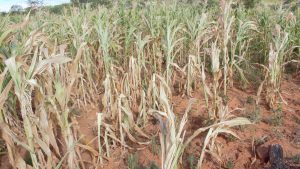

AN increasing number of young people in Shurugwi, 315 km south-west of Harare, are switching from farming to artisanal mining as a result of climate change, which has been linked to a notable decline in agricultural production.
Zimbabwe is highly vulnerable to climate variability and change, with the southern African nation ranking among the top three countries in the world most affected by climate change according to the 2021 Global Climate Risk Index.
Climate change has increased the frequency of extreme weather conditions such as drought, floods, storms, and heat waves. In recent years, rainy seasons have been characterised by heavy rains, hailstorms, and floods, according to the Zimbabwe Meteorological Services Department.
Climate frequency
Climate change in the southern African nation has significantly impacted the frequency and intensity of droughts, according to climate experts.
Takudzwa Mashakwe, a climate expert, said traditionally in Zimbabwe drought occurs on average every five to 10 years.
“Now we experience droughts yearly or after every two to three years. The frequency and intensity of droughts has increased mainly due to significant temperature rises attributed to global climatic changes,” he said.

Midlands had the highest crop write-offs due to erratic and insufficient rainfall accompanied by prolonged dry and hot spells.
Mashakwe highlighted that climate change has contributed to rising youth unemployment in the country, particularly within the agricultural sector.
According to the Zimbabwe National Statistics Agency (ZimStat), 54 percent of the country’s working age population is unemployed.
Shifting patterns
The 10th round of the Rapid Poverty Income Consumption and Expenditure Survey, conducted by ZimStat in 2023, shows that the percentage of households dependent on farming declined from 39 percent to 29 percent, indicating a shift away from agriculture as a primary source of livelihood.
Seeking more lucrative opportunities, Mashakwe said, several young people are turning to artisanal gold and diamond mining.
Having endured successive years of crop failure due to poor and unpredictable rainfall in his home area of Marira village on the outskirts of Shurugwi, 45-year-old Martin Marira recently joined the “great trek” to the brownfields of Wanderer Mine in a desperate search for fortune.
“I used to farm maize but rainfall patterns have become increasingly unpredictable and sometimes we would wait for the rains with no luck. I had to feed my family hence I moved to Wanderer Mine to mine gold,” the father of two said.
Marira said as a small holder farmer, he also used to also rear livestock but the soaring cost of animal feed during dry seasons forced him to give it up.
Currently, the country is facing the worst El Niño-induced drought, with Agriculture Minister Anxious Masuka saying that Zimbabwe experienced the driest start to a season in 40 years this summer season.

The area of maize written-off was 908 004 hectares out of 1,777,540 hectares due to El Niño-induced drought
Environmental effects
As individuals move to artisanal mining due to climate change concerns, climate experts also revealed that environmental concerns have increased.
Climate experts say illegal, small-scale mining for gold has resulted in deforestation, land degradation, water pollution, and loss of biodiversity.
Daniel Sithole a climate change expert and director of Green Shango Environmental Trust said the combined effects of deforestation, land degradation, and water pollution contribute to climate change.
The Environmental Management Agency has flagged an increase in illegal mining activities as a cause for concern stating that it is causing problems such as water pollution, deforestation, poor soil fertility and limited access to land for agriculture productivity.
Forests play a crucial role in carbon sequestration, and their removal increases greenhouse gas emissions.
Land degradation reduces the land’s ability to store carbon, while water pollution affects aquatic ecosystems, which also contributes to carbon sequestration.
Decline in yields
Bornface Madzivanyika, a former agriculture extension officer at the Ministry of Agriculture, said the frequency of droughts has led to a reduction of area planted due to the high risk of uncertainties associated with farming.
According to the final crop assessment by the Ministry of Agriculture, for the 2023/24 summer cropping season, the area of maize written-off was 908 004 hectares out of 1,777,540 hectares due to El Niño-induced drought.
Midlands had the highest write-offs at 273 122 hectares due to erratic and insufficient rainfall accompanied by prolonged dry and hot spells.
Maize production in the 2023/24 season is estimated at 634 699 metric tonnes, down 72 percent from 2,298,281 metric tonnes achieved last year, according to a final crop assessment.
Solutions
Experts say as climate changes, Zimbabwe must prioritise climate-resilient livelihoods including diversifying income sources, promoting sustainable practices, and investing in climate-smart technologies.
“Agriculture can adapt by embracing climate-smart techniques, diversifying crops, and improving water management. These strategies enhance resilience and mitigate climate impacts on farmers’ livelihoods,” Sithole said.
Agriculture Minister Masuka said there is a need for investment in irrigation development to mitigate the effects of climate change.
He said the government is rolling out support schemes for irrigation with the aim of establishing 350 000 hectares under irrigation by 2025 from the current 208 000 hectares.
President Emmerson Mnangagwa recently called for innovative solutions to mitigate the effects of climate change, which is projected to make the region more drought-prone in the coming decades.
“It is now urgent and imperative that we think outside the box for the purpose of de-risking our nation from the vagaries of climate change. Similarly, stakeholders and communities alike should accelerate the implementation and adoption of mechanisms to climate-proof our agriculture sector, beginning at the household level,” he said.
The severe climate shocks in recent years have left developing countries including Zimbabwe more vulnerable due to their low adaptive capacity.
This story is published under the Voluntary Media Council of Zimbabwe Investigative Journalism Fund with support from the Friedrich Naumann Foundation.